Spectral Efficiency Optimization of Uplink Millimeter Wave MIMO-NOMA Systems
Abstract
:1. Introduction
- Aiming at solving the problem of inter-user interference, we proposed an adaptive cluster head selection algorithm based on channel gain and channel correlation, which suppresses inter-user interference by selecting cluster head users.
- Aiming at the problem of inter-beam interference, we proposed analog beamforming based on user channel alignment to solve the problem of inter-beam interference and further improve the SE of the system.
- For the user power allocation problem, the quadratic transformation (QT) method was used to transform a non-convex power allocation problem into a solvable convex problem. Then an iterative approach was designed to obtain optimal power allocation and digital beamforming.
- From the perspective of SE, the proposed joint optimization framework was evaluated by performing simulations. The simulation results demonstrate that our proposed algorithms can significantly enhance SE compared to existing methods by a variety of simulation parameters. Under the parameter setting of this article, the algorithm of this paper outperforms traditional algorithm by about 54.6%.
2. System Model and Problem Formulation
2.1. System Model
2.2. Problem Formulation
3. Solution Approach
3.1. Adaptive Cluster Head Selection Algorithm
| Algorithm 1 Adaptive cluster head selection method |
| Input: The number of users K, and the number of beams G, channel veactors: , , adaptive threshold: . Output: The cluster head set . 1: Calculate channel gains for each user and Sort in descending order, Note O; 2: Selecct the user O(1) with the highest channel gain to ∁; 3: ; 4: ; 5: ; 6: while do 7: if then 8: while do 9: Update adaptive threshold in accordance with (14) 10: ; 11: ; 12: end while 13: end if 14: ; 15: ; 16: ; 17: end while |
3.2. Hybrid Precoding and User Grouping
| Algorithm 2 The algorithm of attributing users to clusters |
| Input: The number of users K, and the number of beams G, channel matrix: , , The cluster head set , number of RF chains , number of BS antennas N, number of quantized phase shifters: B bits. Output: The user grouping scheme: . for do {Reuser represents the number of users except for the cluster header user} for do Calculate user-equivalent channel correlation by (18); end for ; ; ; ; end for |
3.3. Power Allocation
| Algorithm 3 The Quadratic Transform Power Allocation Scheme for SE |
Input: The user grouping scheme: , , , . Output: Power Allocation . repeat Update by (28); Update by solving the convex optimization problem (27) for fixed m; Until converges; |
3.4. Solution Summary and Algorithm Complexity Analysis
| Algorithm 4 Solution Summary |
| Input: The number of users K, channel veactors: ,the number of beams G, the maximum number of iterations: T. Output: The user grouping scheme:, , , Power Allocation . Perform cluster head user selection by Algorithm 1; Perform a phase-aligned analog beamforming by (16) and (17); Attributing users to clusters by Algorithm 2; repeat Calculate the digtal beamformer by (20) and (21); Allocate power for maximizing SE by Algorithm 3; ; Until SE converges or ; |
4. Simulation Results
4.1. Performance Metrics
4.2. Comparison Algorithm Analysis
- Pro: Algorithms 1 and 2 for user grouping, and ZF digital beamforming and Algorithm 3 for digital beamforming and power allocation to maximize system SE.
- SUC: Hierarchical clustering algorithm and S-AGNES algorithm for user grouping and analog beamforming design [21], and ZF precoding method and Algorithm 3 for digital beamforming and power allocation to maximize system SE.
- K-means: User grouping algorithm uses the K-means algorithm [13], the analog beamforming design uses the S-AGNES algorithm, and the digital beamforming and power allocation uses the ZF precoding method and Algorithm 3 to maximize the system SE.
- OMA: The traditional orthogonal multiple access (OMA) algorithm serves only users in the same time domain and is implemented through a ZF precoding and power allocation design, but unlike other algorithms it does not take into account intra-group interference and the decoding order.
4.3. Simulation Analysis
5. Conclusions and Future Work
5.1. Conclusions
5.2. Future Work
Author Contributions
Funding
Institutional Review Board Statement
Informed Consent Statement
Data Availability Statement
Acknowledgments
Conflicts of Interest
References
- Ye, N.; Li, X.; Pan, J.; Liu, W.; Hou, X. Beam aggregation-based mmWave MIMO-NOMA: An AI-enhanced approach. IEEE Trans. Veh. Technol. 2021, 70, 2337–2348. [Google Scholar] [CrossRef]
- Jawarneh, A.; Kadoch, M.; Albataineh, Z. Decoupling energy efficient approach for hybrid precoding-based mmWave massive MIMO-NOMA with SWIPT. IEEE Access. 2020, 1, 1336–1363. [Google Scholar] [CrossRef]
- Solaiman, S.; Nassef, L.; Fadel, E. User clustering and optimized power allocation for D2D communications at mmWave underlaying MIMO-NOMA cellular networks. IEEE Access. 2021, 9, 57726–57742. [Google Scholar] [CrossRef]
- Aghdam, M.R.G.; Tazehkand, B.M.; Abdolee, R. Joint Optimal Power Allocation and Beamforming for MIMO-NOMA in mmWave Communications. IEEE Commun. Lett. 2022, 11, 938–941. [Google Scholar] [CrossRef]
- Wang, S.; Long, Y.; Ruby, R.; Fu, X. Clustering and power optimization in mmWave massive MIMO–NOMA systems. Phys. Commun. 2021, 49, 101469. [Google Scholar] [CrossRef]
- Ding, J.; Cai, J. Two-side coalitional matching approach for joint MIMO-NOMA clustering and BS selection in multi-cell MIMO-NOMA systems. IEEE Trans. Wirel. Commun. 2019, 19, 2006–2021. [Google Scholar] [CrossRef]
- Li, S.; Wan, Z.; Jin, L.; Du, J. Energy harvesting maximizing for millimeter-wave massive MIMO-NOMA. Electronics 2019, 9, 32. [Google Scholar] [CrossRef]
- Wang, B.; Dai, L.; Wang, Z.; Ge, N.; Zhou, S. Spectrum and energy-efficient beamspace MIMO-NOMA for millimeter-wave communications using lens antenna array. IEEE J. Sel. Areas Commun. 2017, 35, 2370–2382. [Google Scholar] [CrossRef]
- Ali, M.S.; Tabassum, H.; Hossain, E. Dynamic user clustering and power allocation in non-orthogonal multiple access (NOMA) systems. IEEE Access. 2016, 4, 6325–6343. [Google Scholar] [CrossRef]
- Xiao, Z.; Zhu, L.; Choi, J.; Xia, P.; Xia, X.G. Joint power allocation and beamforming for non-orthogonal multiple access (NOMA) in 5G millimeter wave communications. IEEE Trans. Wirel. Commun. 2018, 17, 2961–2974. [Google Scholar] [CrossRef] [Green Version]
- Zhu, L.; Zhang, J.; Xiao, Z.; Cao, X.; Wu, D.O.; Xia, X.G. Joint power control and beamforming for uplink non-orthogonal multiple access in 5G millimeter-wave communications. IEEE Trans. Wirel. Commun. 2018, 17, 6177–6189. [Google Scholar] [CrossRef]
- Dai, L.; Wang, B.; Peng, M.; Chen, S. 2Hybrid precoding-based millimeter-wave massive MIMO-NOMA with simultaneous wireless information and power transfer. IEEE J. Sel. Areas Commun. 2019, 37, 131–141. [Google Scholar] [CrossRef]
- Zhu, L.; Zhang, J.; Xiao, Z.; Cao, X.; Wu, D.O.; Xia, X.G. Millimeter-wave NOMA with user grouping, power allocation and hybrid beamforming. IEEE Trans. Wirel. Commun. 2019, 18, 5065–5079. [Google Scholar] [CrossRef]
- Uwaechia, A.N.; Mahyuddin, N.M. Spectrum and energy efficiency optimization for hybrid precoding-based SWIPT-enabled mmWave mMIMO-NOMA systems. IEEE Access. 2020, 8, 139994–140007. [Google Scholar] [CrossRef]
- Zhu, Z.; Deng, H.; Xu, F.; Zhang, W.; Liu, G.; Zhang, Y. Hybrid Precoding-Based Millimeter Wave Massive MIMO-NOMA Systems. Symmetry 2022, 14, 412. [Google Scholar] [CrossRef]
- Sun, Y.; Guo, Y.; Li, S.; Wu, D.; Wang, B. Optimal resource allocation for NOMA-TDMA scheme with α-fairness in industrial internet of things. Sensors 2018, 18, 1572. [Google Scholar] [CrossRef]
- Jain, M.; Soni, S.; Sharma, N.; Rawal, D. Performance analysis at far and near user in NOMA based system in presence of SIC error. Int. J. Electron Commun. 2020, 114, 152993. [Google Scholar] [CrossRef]
- Ghous, M.; Hassan, A.K.; Abbas, Z.H.; Abbas, G. Modeling and analysis of self-interference impaired two-user cooperative MIMO-NOMA system. Phys. Commun. 2021, 48, 101441. [Google Scholar] [CrossRef]
- Zhang, R.; Leung, S.H.; Wang, H.; Tang, W.; Luo, Z. Power Minimization Precoder Design for Uplink MIMO Systems With Multi-Group NOMA Scheme. IEEE Trans. Veh. Technol. 2021, 70, 10553–10569. [Google Scholar] [CrossRef]
- Pawar, A.R.; Kashyap, S.; Chouhan, S. Impact of Max-Min Power Control, Channel Estimation and User Grouping Strategies on Uplink Massive MIMO-NOMA Systems. IEEE Trans. Veh. Technol. 2021, 70, 7858–7869. [Google Scholar] [CrossRef]
- Zhu, J.; Li, Q.; Liu, Z.; Chen, H.; Poor, H.V. Enhanced user grouping and power allocation for hybrid mmWave MIMO-NOMA systems. IEEE Trans.Commun. 2021, 21, 2034–2050. [Google Scholar] [CrossRef]
- Cui, J.; Liu, Y.; Ding, Z.; Fan, P.; Nallanathan, A. Optimal user scheduling and power allocation for millimeter wave NOMA systems. IEEE Trans. Wirel. Commun. 2017, 17, 1502–1517. [Google Scholar] [CrossRef]
- Islam, S.M.; Kim, J.M.; Kwak, K.S. Power do- main non-orthogonal multiple access (NOMA) in 5G systems: Potentials and challenges. IEEE Commun. Surv. Tutor. 2017, 19, 721–742. [Google Scholar] [CrossRef]
- Shen, K.; Yu, W. Fractional programming for communication systems Part I: Power control and beamforming. IEEE Trans. Signal Process. 2018, 66, 2616–2630. [Google Scholar] [CrossRef] [Green Version]


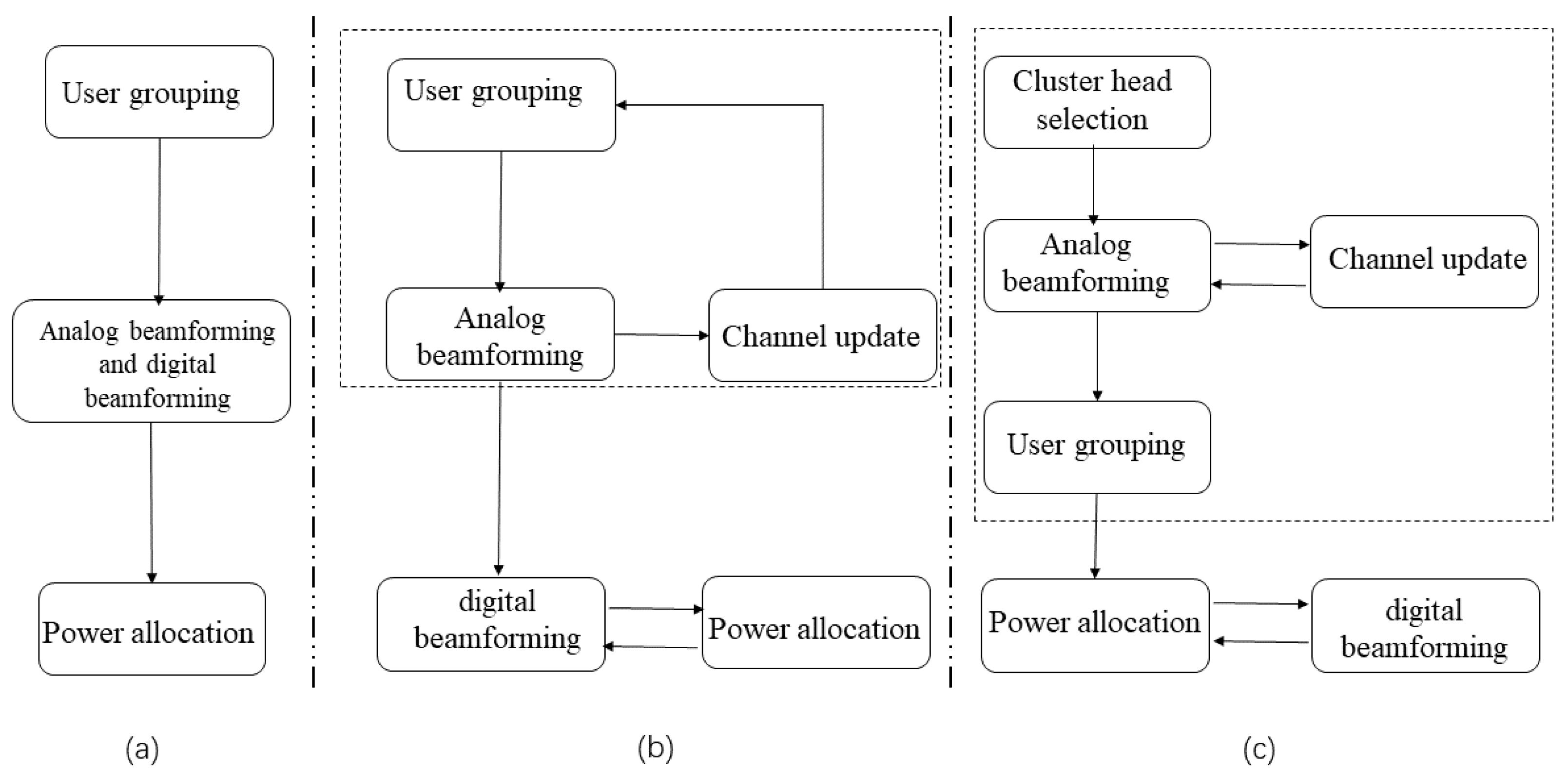
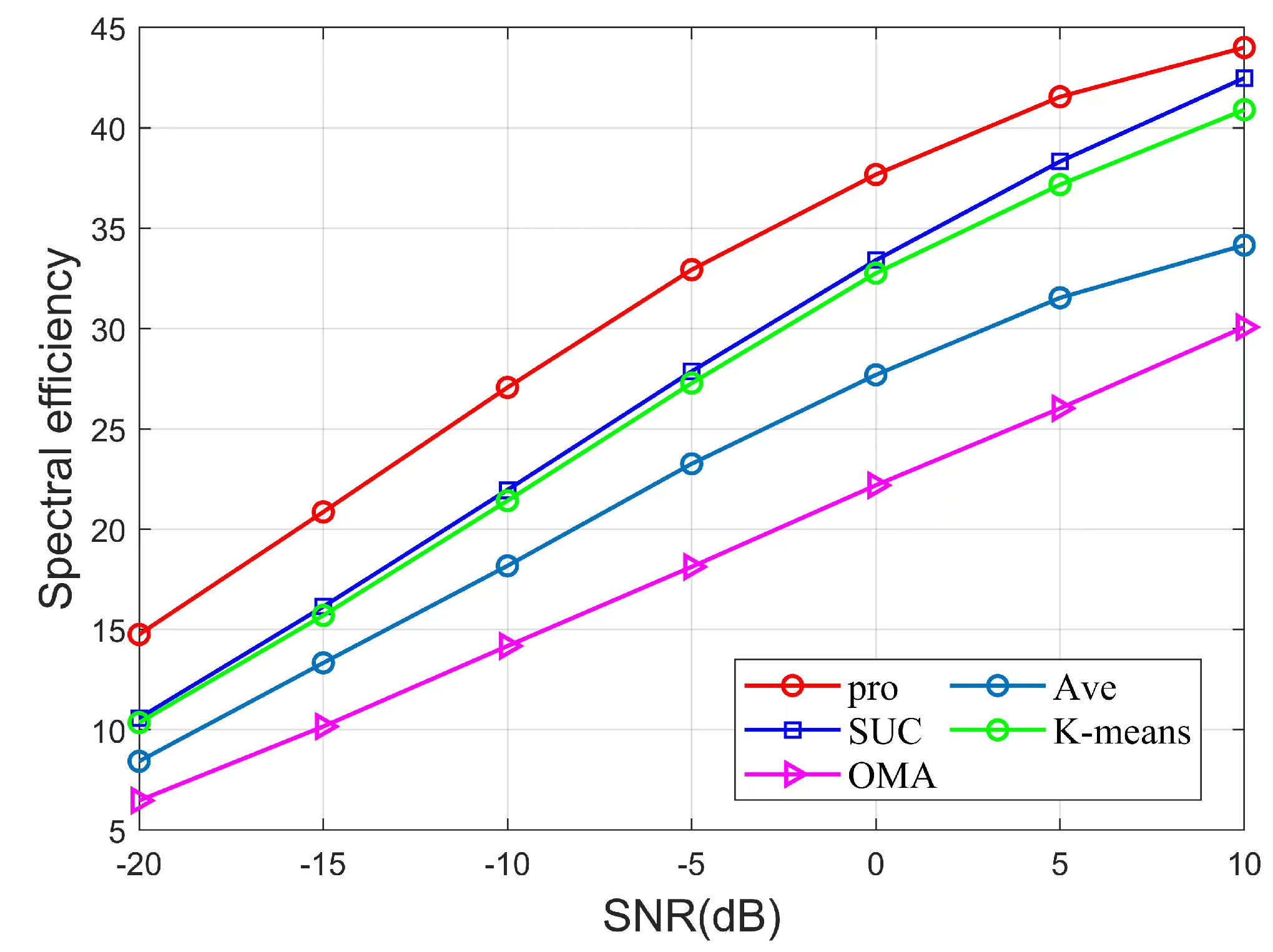
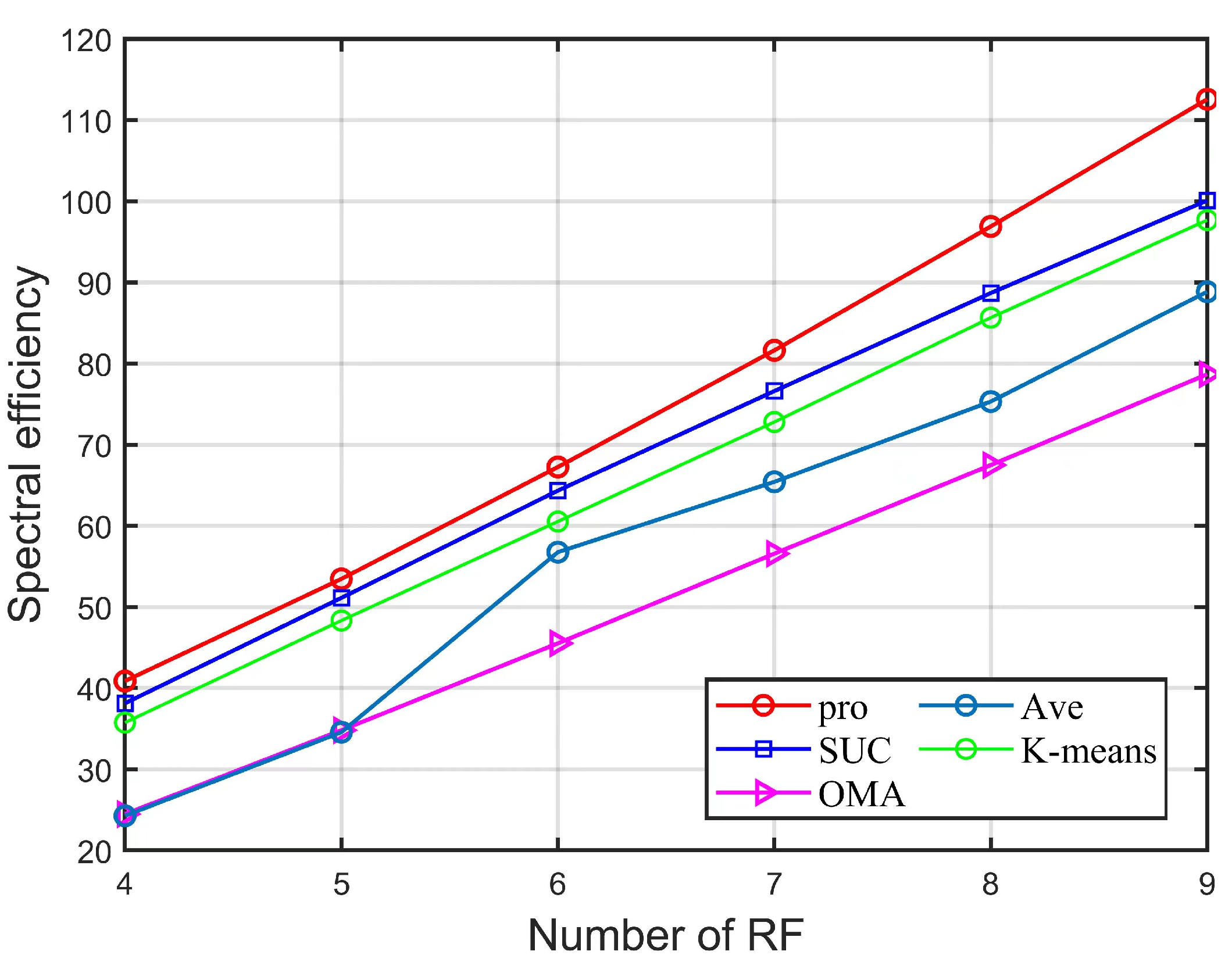
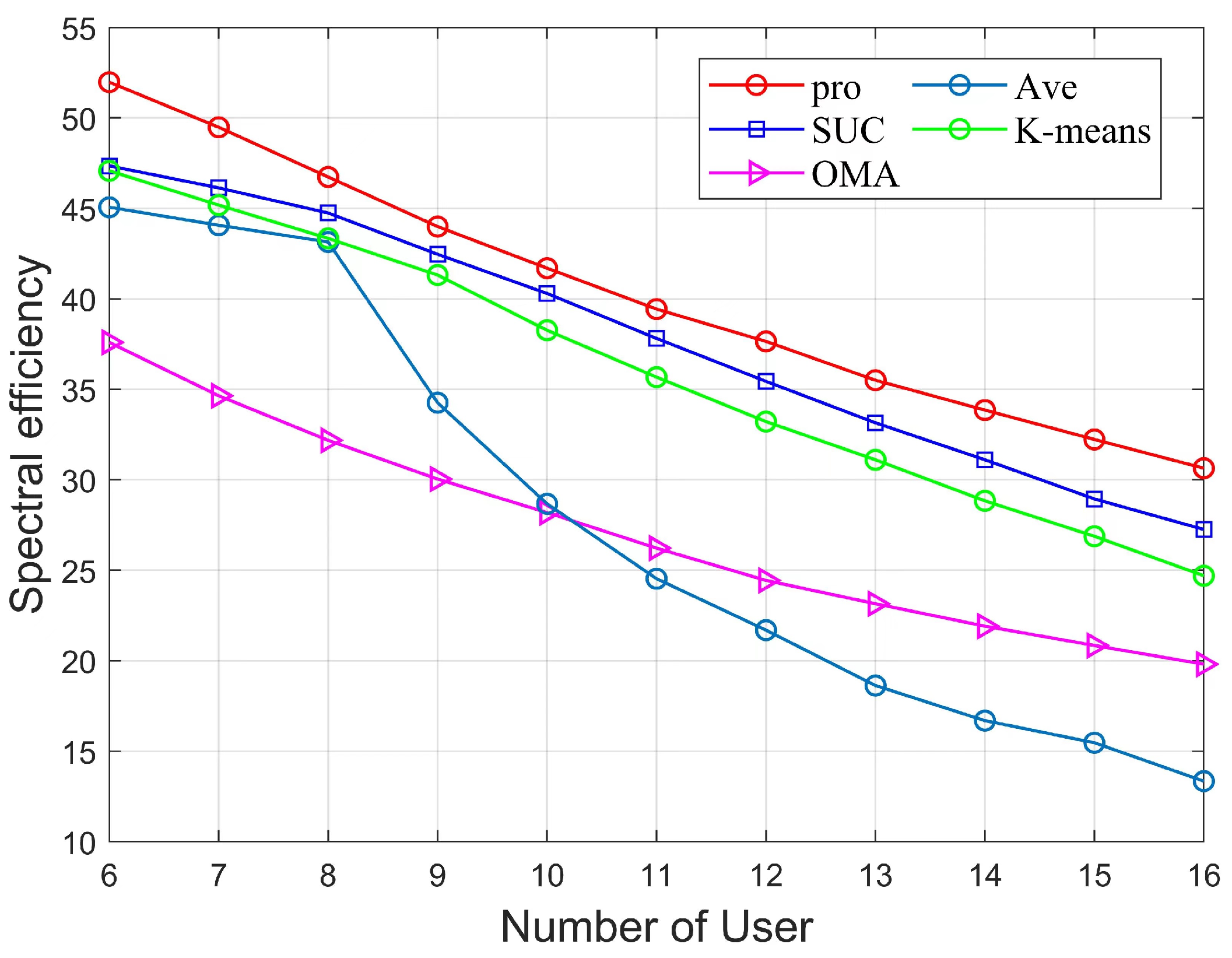

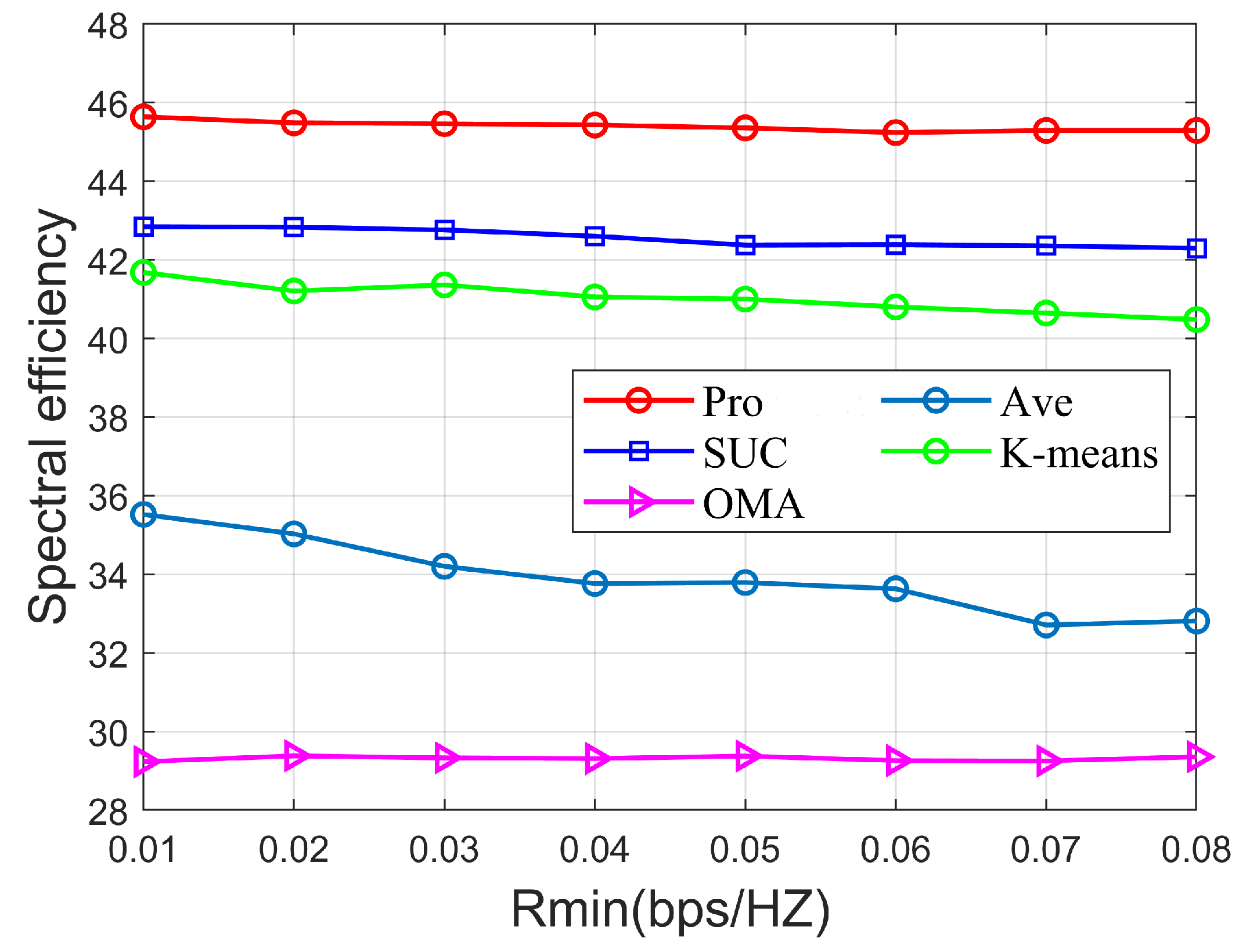
| Parameter | Value |
|---|---|
| Number of scatterers L | 6 |
| Number of anntennas | 64 |
| The resolution of phase shifter B | 4 |
| Number of maximum iteration T | 20 |
| The range of SNR(dB) | [−20, 10] |
| The range of number of user | [6, 16] |
| The range of number of RF chains | [4, 9] |
Publisher’s Note: MDPI stays neutral with regard to jurisdictional claims in published maps and institutional affiliations. |
© 2022 by the authors. Licensee MDPI, Basel, Switzerland. This article is an open access article distributed under the terms and conditions of the Creative Commons Attribution (CC BY) license (https://creativecommons.org/licenses/by/4.0/).
Share and Cite
Zhang, Y.; Deng, H.; He, J.; Zhu, Z.; Peng, C.; Xiao, H. Spectral Efficiency Optimization of Uplink Millimeter Wave MIMO-NOMA Systems. Sensors 2022, 22, 6466. https://doi.org/10.3390/s22176466
Zhang Y, Deng H, He J, Zhu Z, Peng C, Xiao H. Spectral Efficiency Optimization of Uplink Millimeter Wave MIMO-NOMA Systems. Sensors. 2022; 22(17):6466. https://doi.org/10.3390/s22176466
Chicago/Turabian StyleZhang, Yinhao, Honggui Deng, Jun He, Zaoxing Zhu, Chengzuo Peng, and Haoqi Xiao. 2022. "Spectral Efficiency Optimization of Uplink Millimeter Wave MIMO-NOMA Systems" Sensors 22, no. 17: 6466. https://doi.org/10.3390/s22176466
APA StyleZhang, Y., Deng, H., He, J., Zhu, Z., Peng, C., & Xiao, H. (2022). Spectral Efficiency Optimization of Uplink Millimeter Wave MIMO-NOMA Systems. Sensors, 22(17), 6466. https://doi.org/10.3390/s22176466







